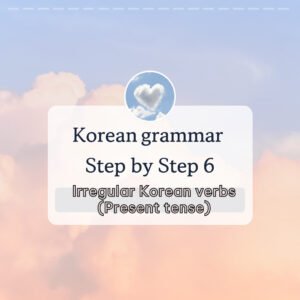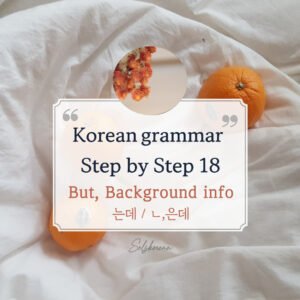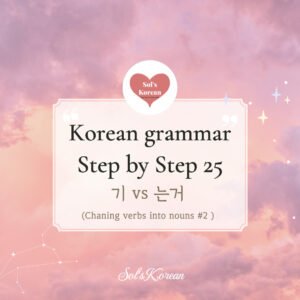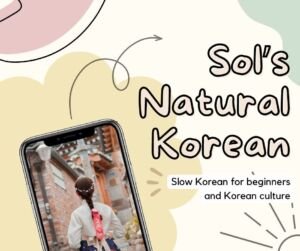Korean Verbs Past tense conjugations
Hello, language learners! Welcome back to our journey of mastering Korean.
Today, we’re going to learn about Korean verbs past tense conjugations, how to form and use the past tense in Korean! It’s a very simple and easy process. This essential skill will help you express yourself more accurately and fully in Korean, allowing you to better communicate your thoughts and experiences.
Let’s dive in!
Part 1,
Let’s grasp the concept of grammar
Let’s recall the present tense grammar rule. Do you remember? We have to find certain vowels (ㅏ, ㅗ ), and depending on those vowels, we conjugate with either 아요 or 어요, right? The past tense follows the same rule!
We will find these two vowels, ㅏ or ㅗ, in the verb stem, and then conjugate with either 았어요 or 었어요.
If there’s “ㅏ or ㅗ” in the verb stem, we conjugate with 았어요
For other vowels, we conjugate with 었어요
For verbs ending in 하다, we conjugate with 했어요
For instance,
(1) 놀다 (to hang out), the verb stem part (놀) has the vowel ㅗ. In this case, we’ll conjugate with 았어요.
놀았어요: hung out.
Informally, you can simply drop the last “요” part. 놀았어(informal)
(2) 먹다(to eat), the verb stem part(먹) has the vowel of ㅓ, we will conjugate with 었어요.
먹었어요: ate.
Informally, you can simply drop the last “요” part. 먹었어(informal)
(3) 전화하다(to call), the verb ends in 하다, so we change it to 했어요.
전화했어요: called.
Informally, you can simply drop the last “요” part. 전화했어(informal)
Let’s take a look at more examples!
가다 (to go) → 갔어요 (went)
가 + 았어요 = 갔어요
*Since the verb stem(가) is ㅏ, we conjugate with 았어요.
There are double “ㅏ” sounds, we omit one!
보다 (to see) → 봤어요 (saw)
보 + 았어요 = 봤어요
*Since the verb stem(보) is ㅗ, we conjugate with 았어요.
We combine two vowels, ㅗ + ㅏ becomes ㅘ!
일어나다 (to wake up) → 일어났어요 (woke up)
일어나 + 았어요 = 일어났어요
*Since the verb stem(나) is ㅏ, we conjugate with 았어요.
There are double “ㅏ” sounds, we omit one!
주다 (to give) → 줬어요 (gave)
주 + 었어요 = 줬어요
*Since the verb stem(주) is ㅜ, we conjugate with 었어요.
We combine two vowels, ㅜ + ㅓ becomes ㅝ!
기다리다 (to wait) → 기다렸어요 (waited)
기다리 + 었어요 = 기다렸어요
*Since the verb stem(리) is ㅣ, we conjugate with 었어요.
Do you remember “ㅣ” contraction? ㅣ + ㅓ becomes ㅕ. 리었 -> 렸!
춤추다 (to dance) → 춤췄어요 (danced)
춤추 + 었어요 = 춤췄어요
*Since the verb stem(추) is ㅜ, we conjugate with 었어요.
We combine two vowels, ㅜ + ㅓ becomes ㅝ!
듣다 (to listen) → 들었어요 (listened) irregular
듣 + 었어요 = 들었어요
*Since the verb stem(듣) is ㅡ, we conjugate with 었어요.
듣다 is one of the ㄷ irregular verbs. ㄷ changes to ㄹ. 들었어요.
If you don’t remember these irregular verbs, check out here!
쓰다 (to write/use) → 썼어요 (wrote) irregular
쓰 + 었어요 = 썼어요
* 쓰다 is ㅡ irregular verbs. We drop ㅡ, and since there’s no prior vowel, we conjugate with 었어요.
If you don’t remember these irregular verbs, check out here!
요리하다 (to cook) → 요리했어요 (cooked)
* For 하다-ending verbs, we simply switch 하다 to 했어요!
여행하다 (to travel) → 여행했어요 (traveled)
* For 하다-ending verbs, we simply switch 하다 to 했어요!
이다 (to be, am/are/is) → 였어요 (was, were)
* “이다” has the vowel ㅣ, so we add 었어요. It becomes 이었어요. Then, we contract ㅣ + 어 to become 였, following the “ㅣ” contraction rule.
You often hear Koreans saying 요리했었어요 (cooked) or 먹었었어요 (ate), where the past tense marker -었- is add or repeated. This repetition, categorized as “past perfect” in grammar, is used to indicate that something happened further in the past or to emphasize past actions. However, this form is also commonly used as a standard past tense in everyday speech.
You will commonly hear these forms (갔었어요, 놀았었어요, 읽었었어요, 공부했었어요).
But don’t worry, many times they are used simply as regular past tense forms!
Now, let’s learn how to form the past continuous tense in Korean. Do you remember the “-ing” grammar points? We have two: -고 있다 and -는 중이다. We can conjugate these to express a past ongoing state, such as “I was swimming” and “I was sleeping.”
We will conjugate the last ending 있다 and 이다 part, which change to 있었어요 and 였어요.
I was swimming : 수영하고 있었어요. 수영하는 중이였어요.
I was running: 달리고 있었어요. 달리는 중이였어요.
I was sleeping: 자고 있었어요. 자는 중이였어요.
I was playing games: 게임하고 있었어요. 게임하는 중이였어요.
Now, let’s practice making sentences together using the past tense.
Let’s get started!






